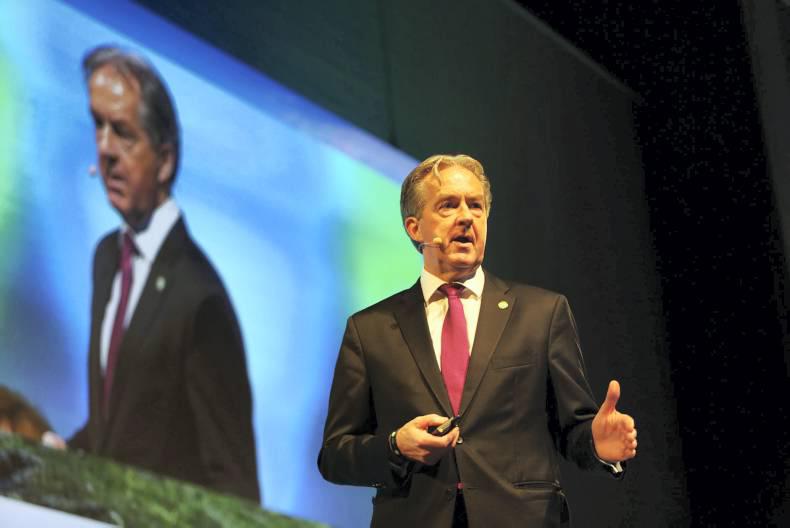Figures released by Bord Bia on Wednesday morning show that Irish food and drink exports for 2015 increased by 3% for 2015 to a new record of €10.8bn. While better returns for beef, seafood and beverages helped offset the decline in dairy commodity values, a major factor in the improved export performance was favourable currency trends.
So much so that Bord Bia estimates positive exchange rate developments over the year contributed close to a €1bn to the overall performance of Irish food and drink exports.
Sterling boost
Despite significant investment in expanding into new international markets, the majority of food and drink export growth in 2015 went to our nearest market, the UK.
Irish food and drink exports to the UK grew by 7% in 2015 to an estimated €4.4bn. This means our most important trading partner accounted for 41% of all food and drink exports last year, with stronger export values for beef, prepared foods, mushrooms and poultry helping to offset lower beverage and dairy figures.
The greatest driver of the increase in exports to the UK was undoubtedly the depreciation of the euro against sterling over 2015, helping to improve the competitiveness of Irish exports greatly.
The single currency weakened by almost 11% against the sterling at one point in the year, with the euro particularly weak between early March and late August 2015.
There was some recovery into October before the value of the euro against sterling plunged once again in November before rallying somewhat in December.
With 54% of Irish beef exports, 70% of prepared consumer foods (PCF) exports and 44% of prepared foods exports all destined for the UK market last year, the weakened euro acted as a major boost to their competitiveness in our most important market.
US dollar and Chinese yuan
Sterling was not the only currency that the euro depreciated against in 2015. The US dollar gained steady momentum throughout 2015, hardening against the euro by 16% last year, which also helped Irish exports to countries where currencies are pegged to the dollar.
The euro also weakened by 15% against the Chinese yuan, helping increase exports to China by 16% in 2015. However, the yuan has been in reverse in recent months and this will be a challenge over the coming year for exporters.
Overall, Bord Bia estimates that favourable currency tailwinds for the euro in 2015 relative to sterling and the dollar benefited Irish food and drink exports by €950m.
Read more
Ireland supplies 10% of all global infant milk formula – Bord Bia
China – Ireland’s second largest food market
Podcast: exporting beef to America may not be as straightforward as it seems
Weak euro strengthens hands of food exporters
Have exports reached their peak?
Irish food exports to Russia plunged 70% in 2015
Bord Bia to open offices in Singapore and Warsaw
Figures released by Bord Bia on Wednesday morning show that Irish food and drink exports for 2015 increased by 3% for 2015 to a new record of €10.8bn. While better returns for beef, seafood and beverages helped offset the decline in dairy commodity values, a major factor in the improved export performance was favourable currency trends.
So much so that Bord Bia estimates positive exchange rate developments over the year contributed close to a €1bn to the overall performance of Irish food and drink exports.
Sterling boost
Despite significant investment in expanding into new international markets, the majority of food and drink export growth in 2015 went to our nearest market, the UK.
Irish food and drink exports to the UK grew by 7% in 2015 to an estimated €4.4bn. This means our most important trading partner accounted for 41% of all food and drink exports last year, with stronger export values for beef, prepared foods, mushrooms and poultry helping to offset lower beverage and dairy figures.
The greatest driver of the increase in exports to the UK was undoubtedly the depreciation of the euro against sterling over 2015, helping to improve the competitiveness of Irish exports greatly.
The single currency weakened by almost 11% against the sterling at one point in the year, with the euro particularly weak between early March and late August 2015.
There was some recovery into October before the value of the euro against sterling plunged once again in November before rallying somewhat in December.
With 54% of Irish beef exports, 70% of prepared consumer foods (PCF) exports and 44% of prepared foods exports all destined for the UK market last year, the weakened euro acted as a major boost to their competitiveness in our most important market.
US dollar and Chinese yuan
Sterling was not the only currency that the euro depreciated against in 2015. The US dollar gained steady momentum throughout 2015, hardening against the euro by 16% last year, which also helped Irish exports to countries where currencies are pegged to the dollar.
The euro also weakened by 15% against the Chinese yuan, helping increase exports to China by 16% in 2015. However, the yuan has been in reverse in recent months and this will be a challenge over the coming year for exporters.
Overall, Bord Bia estimates that favourable currency tailwinds for the euro in 2015 relative to sterling and the dollar benefited Irish food and drink exports by €950m.
Read more
Ireland supplies 10% of all global infant milk formula – Bord Bia
China – Ireland’s second largest food market
Podcast: exporting beef to America may not be as straightforward as it seems
Weak euro strengthens hands of food exporters
Have exports reached their peak?
Irish food exports to Russia plunged 70% in 2015
Bord Bia to open offices in Singapore and Warsaw






 This is a subscriber-only article
This is a subscriber-only article










SHARING OPTIONS: